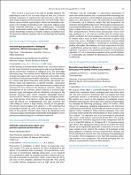Options
Activated algae granulation: A biological solution for efficient microalgae harvesting
Date issued
2015
Author(s)
Tiron, Olga
Bumbac, Costel
Patroescu, Viorel Ion
Stefanescu, Mihai
Abstract
A novel biological method was developed as an alternative solution for the major drawback in developing the microalgae biotechnology for wastewater treatment at industrial scale: the microalgae harvesting step. The method allows efficient and fast harvesting of target microalgae cells (such as Chlorella sp.) and consists in the
granulation of the photoautotrophic microalgae – bacteria biomass, in a stirred tank photo-bioreactor with specific operational conditions, using real wastewater as growth medium. Granulation process requires the presence of the filamentous microalgae which represent the base matrix of the biological structure. During the
development of the granular entities, termed as activated algae granules, target microalgae cells are efficiently entrapped in the granular structure, thus almost complete microalgae biomass recovery (99.15–99.99%) is ensured by granules settling only. Moreover, high density of the biomass within the granule’s structure (with 80–300 ug dry weight/granule) and large granules’ size (500–3000 um) ensure a high settling velocity of the granules (18–29 m/h) which is higher with about 3–5 × 103 times than that of individual Chlorella sp. cells. Such performances prove the viability of the granular activated algae system by sustaining a cost saving microalgae harvesting strategy for the development of a new generation biotechnology for wastewater treatment.
granulation of the photoautotrophic microalgae – bacteria biomass, in a stirred tank photo-bioreactor with specific operational conditions, using real wastewater as growth medium. Granulation process requires the presence of the filamentous microalgae which represent the base matrix of the biological structure. During the
development of the granular entities, termed as activated algae granules, target microalgae cells are efficiently entrapped in the granular structure, thus almost complete microalgae biomass recovery (99.15–99.99%) is ensured by granules settling only. Moreover, high density of the biomass within the granule’s structure (with 80–300 ug dry weight/granule) and large granules’ size (500–3000 um) ensure a high settling velocity of the granules (18–29 m/h) which is higher with about 3–5 × 103 times than that of individual Chlorella sp. cells. Such performances prove the viability of the granular activated algae system by sustaining a cost saving microalgae harvesting strategy for the development of a new generation biotechnology for wastewater treatment.
Files
Loading...
Name
activated algae granulation Olga.pdf
Size
58.23 KB
Format
Adobe PDF
Checksum
(MD5):0d1dda8958afe94e9afc478e3ab11228